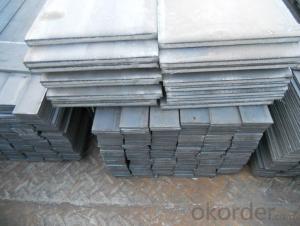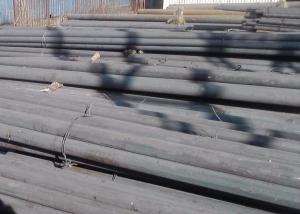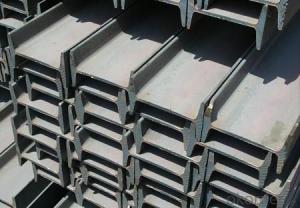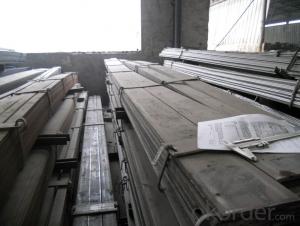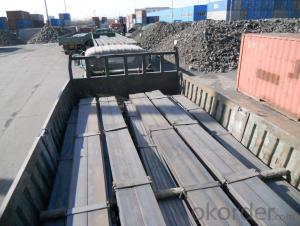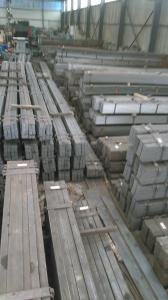Standard Size Q235 Hot Rolled Steel Flats from China
- Loading Port:
- China main port
- Payment Terms:
- TT or LC
- Min Order Qty:
- 50 m.t.
- Supply Capability:
- 200000 m.t./month
OKorder Service Pledge
OKorder Financial Service
You Might Also Like
Details of Standard Size Q235 Hot Rolled Steel Flats from China
| Minimum Order Quantity: | 25MT | Unit: | m.t. | Loading Port: | China Main Port |
| Supply Ability: | 80000-100000MTS/YEAR | Payment Terms: | TT or LC |
Specification of Standard Size Q235 Hot Rolled Steel Flats from China
Commodity: Q235 Steel Flat Bar
Standard: GB
Material: Q235
Brand name: FLATSPACE
Origin place: China
Thickness: 3mm-30mm
Width:20mm-200mm
Length: Max 12m
Certification: SGS/BV
Chemical composition of Standard Size Q235 Hot Rolled Steel Flats from China
Alloy No | Grade | Element(%) | ||||
C
| Mn
| S
| P
| Si
| ||
Q235
|
B
|
0.12—0.20 |
0.3—0.7 |
≤0.045 |
≤0.045
|
≤0.3
|
Physical properties of Standard Size Q235 Hot Rolled Steel Flats from China
Alloy No | Grade | Yielding strength point(Mpa) | Tensile strength (Mpa) | Elongation after fracture(%) | ||||||
Thickness (mm) | Thickness (mm) | |||||||||
≤16 | >16--40 | >40--60 | >60--100 |
| ≤16 | >16--40 | >40--60 | >60--100 | ||
≥ | ≥ | |||||||||
Q235 |
B |
235 |
225 |
215 |
205 |
375--500 |
26 |
25 |
24 |
23 |
Usage/Applications of Standard Size Q235 Hot Rolled Steel Flats from China
Widely used for construction, Machinery manufacturing, Iron tower steel structure, Shipbuilding; Steel grating, Staircase, Bridge, Viaduct, Railway spare parts, Boilers making etc.
Production Flow of Standard Size Q235 Hot Rolled Steel Flats from China
The steel flat bar is made through three processes:
1.Feeding the material: Feeding the row material (the steel plate) to Slitting Line.
2.Slitting:The steel plate would be slitted into expected width by lengthways cutter.
3. Leveled and cutting: The plat bar would be ground into level by the grinder and then cut into required length.
Packaging & Delivery of Standard Size Q235 Hot Rolled Steel Flats from China
Packaging Details: The Steel Flat Bars are packed in bundles and loaded in 20 feet/40 feet container, or shipped by bulk cargo ,also we can do as customer's requirements.
Delivery Details:30~45 days upon the receipt of buyer payment by T.T. or L/C.
Pictures of Standard Size Q235 Hot Rolled Steel Flats from China

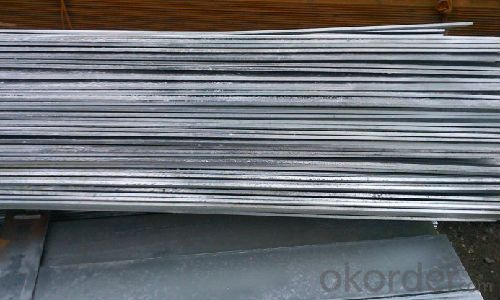
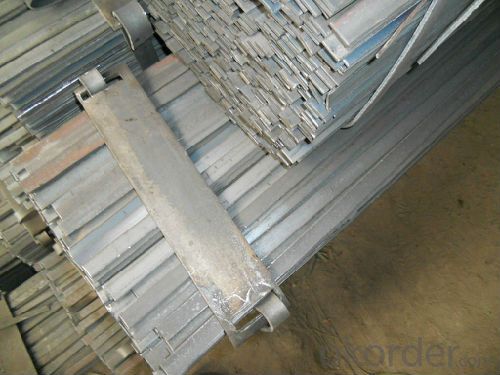
- Q:Are steel flat bars suitable for welding to other materials?
- Yes, steel flat bars are suitable for welding to other materials. Steel is a versatile material that can be easily welded to various other metals and materials. Steel flat bars are commonly used in construction, manufacturing, and fabrication industries, and they can be welded to materials such as aluminum, stainless steel, and even other types of steel. Welding steel flat bars to other materials allows for the creation of strong and durable structures or components. However, it is important to ensure proper preparation, including cleaning and surface preparation, to achieve a successful weld. Additionally, selecting the appropriate welding method and filler material is crucial to ensure a strong bond between the steel flat bar and the other material. Overall, steel flat bars are a reliable choice for welding to other materials due to their strength, versatility, and compatibility with various welding processes.
- Q:Can steel flat bars be used in the aerospace industry?
- Yes, steel flat bars can be used in the aerospace industry. Steel is a widely used material in various industries, including aerospace, due to its excellent strength, durability, and versatility. Steel flat bars can be used in the construction of aircraft frames, wings, landing gears, and other structural components. They provide a strong and reliable support system, ensuring the structural integrity and safety of the aircraft. Additionally, steel flat bars can be machined and fabricated to meet the specific requirements and performance standards of the aerospace industry.
- Q:Are steel flat bars suitable for welding with other metals?
- Yes, steel flat bars are suitable for welding with other metals. Steel is a versatile material that can be easily welded to other metals through various welding techniques such as MIG (Metal Inert Gas), TIG (Tungsten Inert Gas), or stick welding. When welding steel flat bars with other metals, it is essential to ensure proper surface preparation, such as cleaning any rust, dirt, or contaminants, and selecting the appropriate welding method and filler material compatible with the specific metals being welded. Additionally, the welder should consider the desired strength, durability, and intended application of the final welded product. Overall, steel flat bars offer a reliable and practical option for welding with other metals, making them suitable for a wide range of welding applications.
- Q:Can steel flat bars be used in high-temperature environments?
- Yes, steel flat bars can be used in high-temperature environments, but the specific type of steel used will determine its suitability. Stainless steel flat bars, for example, are often used in high-temperature applications due to their ability to resist corrosion and maintain their strength at elevated temperatures. Certain grades of stainless steel, such as 304 and 316, can withstand temperatures up to 870°C (1600°F) and 925°C (1700°F), respectively. Additionally, heat-resistant alloys like Inconel and Hastelloy are commonly used for high-temperature applications as they can maintain their mechanical properties even at extremely high temperatures. However, it is important to consider the specific temperature range, duration of exposure, and the potential for other factors like oxidizing or reducing atmospheres that may affect the performance of steel flat bars in high-temperature environments. Therefore, it is crucial to consult with materials engineers or experts to determine the best steel flat bar for a specific high-temperature application.
- Q:Are steel flat bars heat-treatable?
- Yes, steel flat bars are heat-treatable.
- Q:Do steel flat bars have a specific tolerance range?
- Steel flat bars indeed possess a specific tolerance range. Tolerance pertains to the permissible deviation from the designated dimensions or attributes of a product. In relation to steel flat bars, the tolerance range typically encompasses variances in terms of thickness, width, and length. The precise tolerance range may differ based on manufacturing standards, steel grade, and the intended application of the flat bars. These tolerances hold significance in guaranteeing that the flat bars satisfy the necessary specifications and can be efficiently utilized in diverse construction and industrial applications.
- Q:Are steel flat bars commonly used in the telecommunications industry?
- No, steel flat bars are not commonly used in the telecommunications industry.
- Q:Can steel flat bars be used for automotive applications?
- Yes, steel flat bars can be used for automotive applications. They are commonly used in the manufacturing of various parts, such as brackets, supports, and frames, due to their strength, durability, and versatility.
- Q:What is the typical weight of a steel flat bar?
- The typical weight of a steel flat bar can vary depending on its dimensions and the specific type of steel used. Generally, a steel flat bar can weigh anywhere between a few pounds to several hundred pounds. It is best to refer to the manufacturer's specifications or consult a metal weight calculator for a more precise estimation based on the specific dimensions and type of steel flat bar.
- Q:What is the tolerance for thickness in steel flat bars?
- The tolerance for thickness in steel flat bars can vary depending on industry standards and requirements specific to each sector. Typically, the tolerance for thickness in steel flat bars is specified as a plus or minus value. For instance, a common tolerance for thickness in steel flat bars may be +/- 0.005 inches. This indicates that the actual thickness of the steel flat bar can deviate by up to 0.005 inches in either direction from the specified thickness. However, it is important to highlight that the tolerance for thickness may differ depending on the grade, type, and application of the steel flat bars. Therefore, it is crucial to refer to the manufacturer's guidelines and industry standards to determine the precise tolerance for thickness in steel flat bars for a specific application.
1. Manufacturer Overview |
|
|---|---|
| Location | |
| Year Established | |
| Annual Output Value | |
| Main Markets | |
| Company Certifications | |
2. Manufacturer Certificates |
|
|---|---|
| a) Certification Name | |
| Range | |
| Reference | |
| Validity Period | |
3. Manufacturer Capability |
|
|---|---|
| a)Trade Capacity | |
| Nearest Port | |
| Export Percentage | |
| No.of Employees in Trade Department | |
| Language Spoken: | |
| b)Factory Information | |
| Factory Size: | |
| No. of Production Lines | |
| Contract Manufacturing | |
| Product Price Range | |
Send your message to us
Standard Size Q235 Hot Rolled Steel Flats from China
- Loading Port:
- China main port
- Payment Terms:
- TT or LC
- Min Order Qty:
- 50 m.t.
- Supply Capability:
- 200000 m.t./month
OKorder Service Pledge
OKorder Financial Service
Similar products
New products
Hot products
Hot Searches
Related keywords
